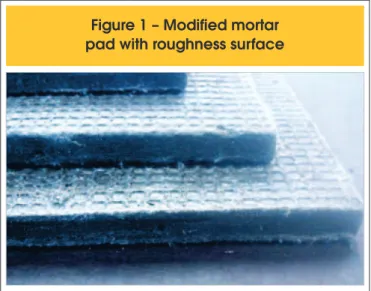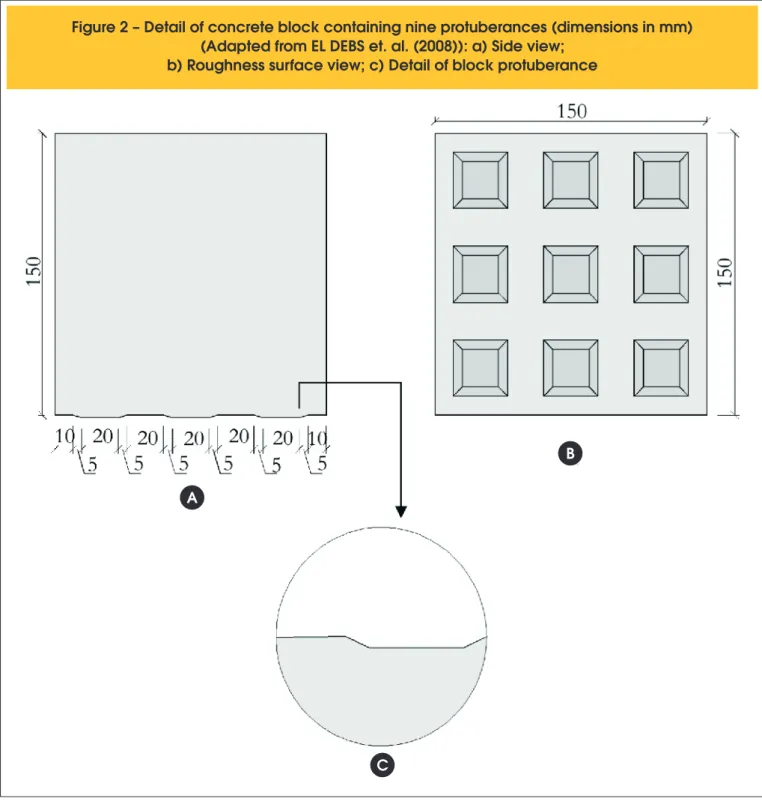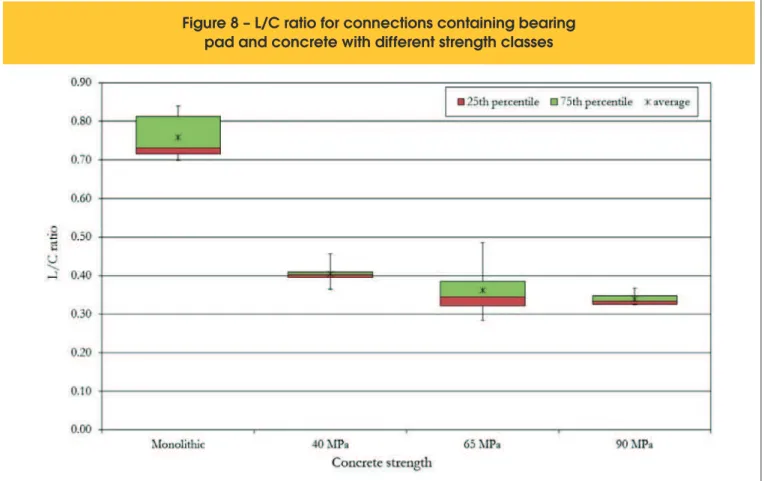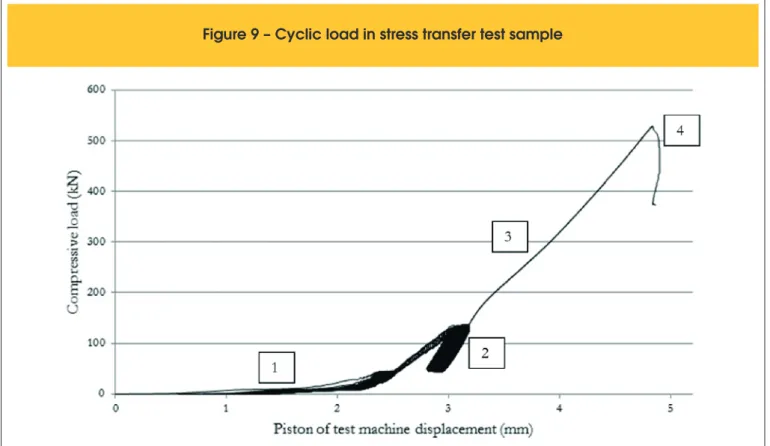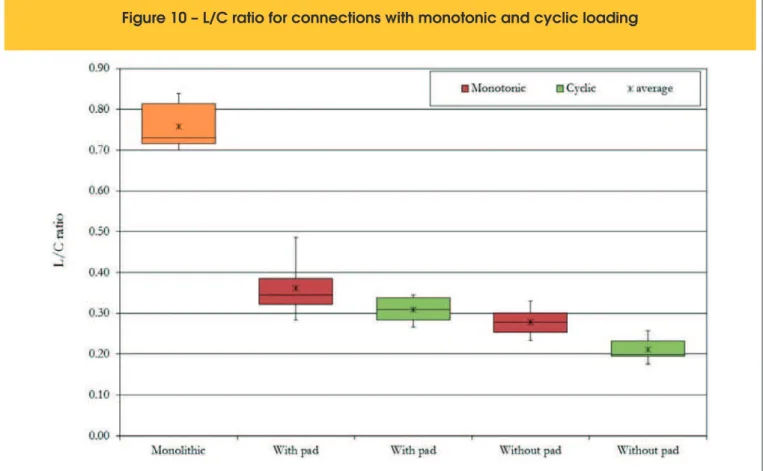Modiied mortar pad behavior in the transfer
of compressive stresses
Comportamento de almofadas de argamassa modiicada
na transferência de tensões de compressão
a Faculdade Meridional - IMED, Escola de Engenharia Civil, Passo Fundo, RS, Brasil;
b Universidade de São Paulo, Departamento de Estruturas, Escola de Engenharia de São Carlos, São Carlos, SP, Brasil; c Universidade Estadual de Campinas, Departamento de Estruturas, Campinas, SP, Brasil.
Abstract
Resumo
This research aims to analyze the compressive stress transfer between precast concrete elements using cement mortar pads modiied with polypropylene ibers, styrene-butadiene latex and heat-expanded vermiculite. The stress transfer analyses are performed interleaving a cement-bearing pad between two concrete blocks, subjecting the entire specimen to diferent compressive load tests. The parameters analyzed in the tests are: surface roughness (using bosses on the bonded phase of diferent thicknesses), compressive strength with monotonic and cyclic loadings. The main results obtained in this study are: a) the presence of pad increased the strength in 24% for thicknesses of imperfections of 0.5 mm and approximately 12% for smooth faces blocks; b) gain of efectiveness of the bearing pad when the concrete strength was reduced; c) for cyclic loading, the bearing pad increased in 48% the connections strength.
Keywords: bearing pad, mortar pad, stress transfer.
O objetivo deste trabalho é analisar a transferência de tensões de compressão entre elementos de concreto pré-moldado através de almofadas de argamassa modiicadas com ibras de polipropileno, látex estireno-butadieno e vermiculita termo-expandida. As análises de transferência de tensões foram realizadas intercalando uma almofada entre dois blocos de concreto e submetendo o corpo de prova a ensaios de compressão. Os parâmetros variados foram: rugosidade supericial (saliências na face ligada de diferentes espessuras), resistência à compressão do concreto dos blocos e carregamento monotônico e cíclico. Os principais resultados dos ensaios de ligação foram: a) a presença da almofada aumentou a resistência em 24% para espessuras de saliências de 0,5 mm e cerca de 12% para blocos com faces ligadas lisas; b) a efetividade da almofada aumentou à medida que se reduziu a resistência à compressão do concreto; c) para carregamento cíclico, a almofada de apoio aumentou em 48% a resistência da ligação.
Palavras-chave: almofada de apoio, almofada de argamassa modiicada, transferência de tensões.
J. D. DITZ a
1. Introduction
The connections between precast concrete elements are very im-portant in the design of this type of structural solution [1-2]. Depend-ing on the existent supericial irregularities in precast elements, a stress concentration with early rupture can occur in the region of connections with direct contact. A possibility to avoid these stress concentrations are the use of a bearing pad between the connect-ed parts. The use of these pads tend to distribute uniformly the compressive stresses, allowing some relative movement between the precast elements.
The most commonly used materials in the pad is the polychloro-prene. The other alternatives used to transfer the compressive stress in the contact surfaces are the fulillment of the space between ele-ments with grout or the use of a steel plate in the connection. Instead of the use of these classical materials, this work analyzes the compressive stress transfer in precast concrete connections using an alternative cement-based material, simply called here as a modiied mortar pad (MMP). The MMP is produced introducing in the Portland cement-based mortar a styrene-butadiene latex, poly-propylene ibers and heat-expanded vermiculite. The use of these additions results in a material with greater deformability and higher toughness, compared to an ordinary cement mortar, being able to transfer the compressive stresses in an appropriate manner. More details about these types of alternative materials and their applica-tions can be found in EL DEBS [3].
Compression tests were conducted in concrete samples, simu-lating column-to-column connections, composed of two prismatic blocks interleaved with a MMP and the results were compared to a monolithic specimen [4-5]. The pads had 10 mm thick and smooth surface, with average compressive strength of 34.9 MPa, average tensile strength of 2.66 MPa and average elastic modulus of 13.1 GPa. The concrete blocks had compressive strength ranging from 52 to 61 MPa. Some of the upper concrete blocks had a rough surface, with diferent thicknesses ranging from 0.75 mm to 1.5 mm, which aimed to simulate the imperfections found in real struc-tures. The experimental results revealed that presence of the MMP increased the connection strength in samples with the thickness of rough surface between 0.75 mm and 1.0 mm. For specimens with smooth surface and rough surface of 1.5 mm thickness, there were no signiicant increase in the connection strengths.
SIQUEIRA & EL DEBS [5] also evaluated the stifness of MMP with smooth surface under cyclic loads. After some tests varying the number of cycles and the level of compressive load applied, the experimental results demonstrated that the stifness for the MMP did not sufered signiicant change when compared to samples loaded monotonically. These results conirmed the resilient capac-ity of the pad. Additionally, it was observed that with an increase in the amount of vermiculite in the mixture, there was a signiicant
reduction in the mechanical properties of the composite material. They concluded that the optimal amount of vermiculite in the com-posite was around 10%.
EL DEBS e & BELLUCIO [6] introduced a small surface roughness in the MMP observing that the presence of this surface roughness tends to reduce the stifness of the pad in the hardened state. In this study, two diferent diameters for the polypropylene ibers (12 μm and 180 μm) were tested in the mixtures. After some experi-mental tests, it was concluded that the use of polypropylene iber with a diameter of 12 μm provided smaller stifness and greater toughness values to the material.
This current research aims to continue to the study that has been done in the School of Enginnering of São Carlos since the late nineties. Compressive tests are performed in connections between concrete specimens with and without MMP, varying the thickness of the rough surface of prismatic blocks, the concrete compressive strength and the type of load (monotonic and cyclic) applied on the blocks. The experimental test program conducted in this study aims to verify the behavior and the applicability limits for the MMP, simulating diferent situations for column-to-column connections of precast concrete that can be found in real structures. More detailed information about the tests performed and the results obtained are available in DITZ [7].
2. Materials and experimental program
The MMP production is carried out using the products described as follow: a) Portland cement CP-V-ARI; b) Sand with spe-ciic mass of 2630 kg/m³ and a maximum diameter of 0.6 mm; c) Heat-expanded vermiculite with speciic mass of 113 kg/m³;
Table 1 – Reference mixture for the MMP (in mass)
Cement Sand Vermiculite Latex Fiber Superplasticizer Water
Cement consumption
(kg/m³)
1 0.285 0.015 0.1 0.02 0.025 0.25 1220
d) Styrene-butadiene latex with solid contents of 50%; e) Polypro-pylene ibers with length of 10 mm and diameter of 12 μm; and f) Superplasticizer Glenium 51.
The base mixture of the MMP used in this work is presented in Table [1]. The cure process adopted in this study was based on the recommendations of RAY & GUPTA [8] for cementitious com-posites modiied with polymers. The irst 48 hours with 100% of humidity (moist chamber). After this period, the samples were cured in dry conditions, at ambient temperature with at least 50%
humidity. All tests were performed with the age of pads between 14 to 21 days.
To determine the mechanical properties of the cement mortar com-position used in this study, cylindrical samples with 50 mm diame-ter and 100 mm height were tested. The results of the experimental tests demonstrates that the mixture has an average compressive strength of 27.65 MPa, an average tensile strength of 3.62 MPa and an average static elastic modulus of 11.53 MPa.
To evaluate the capacity to transfer the compressive stresses of
Figure 2 – Detail of concrete block containing nine protuberances (dimensions in mm)
(Adapted from EL DEBS et. al. (2008)): a) Side view;
b) Roughness surface view; c) Detail of block protuberance
A
B
the cement-based bearing pad for precast concrete connections, samples of 150 mm x 150 mm x 10 mm (MMP) with rough sur-face, as can be seen in Figure [1], were introduced between cubic concrete blocks with 150 mm of lateral edges. The upper concrete block had nine protuberances in the connection surface with vari-able thickness of 0.50 mm, 1.0 mm and 1.50 mm, as indicated in Figure [2]. In addition to these intentional roughnesses, a connec-tion with smooth surface is also considered in this research. All the results are compared to a prismatic monolithic concrete block with
150 mm x 150 mm of base and 300 mm height. In addition to the surface roughnesses, another variable also evaluated is the efec-tive contribution of the MMP for connections using concrete with diferent average compressive strengths. In this case, the MMP is placed between concrete blocks with compressive strengths of 40, 65 and 90 MPa, with a ixed value of 1.0 mm for the protuberances in the upper concrete block.
For each casting, six cylindrical samples with 10 cm x 20 cm were molded as a control of compressive strength. For the tests that
Table 2 – Series analyzed in the connection tests
Serie
Protuberance thickness
(mm)
Blocks concrete compressive strength class
(MPa)
Presence of bearing pad
Monotonic or cyclic regime
S065SM 0 65 Yes Monotonic
S0.565SM 0.5 65 Yes Monotonic
S1.065SM 1.0 65 Yes Monotonic
S1.565SM 1.5 65 Yes Monotonic
S065NM 0 65 Not Monotonic
S0.565NM 0.5 65 Not Monotonic
S1.065NM 1.0 65 Not Monotonic
S1.565NM 1.5 65 Not Monotonic
S1.040SM 1.0 40 Yes Monotonic
S1.090SM 1.0 90 Yes Monotonic
S1.065SC 1.0 65 Yes Cyclic
S1.065NC 1.0 65 Not Cyclic
Monolithic – 65 – Monotonic
Figure 3 – a) Block containing protuberances in one surface after desmolding;
b) Block with protuberances in featured
aimed to verify the efective capacity of MMP to transfer the com-pressive stresses varying the thickness of protuberances in upper concrete blocks, a concrete with a constant value of 65 MPa for the compressive strength is used.
The results are presented directly in function of the compressive strength of the connection, with or without MMP, being compared to the strength of a monolithic concrete block. To be able to evaluate the efective capacity of the MMP to transfer compressive stresses of connections using concrete blocks with diferent compressive strenghts, a coeicient called L/C relationship is stipulated. This coeicient comes from the ratio between the connection strength and the average compressive strength of the cylindrical concrete samples (10 cm x 20 cm), considered as a reference of concrete compressive strength. Therefore, the connection strength for concrete with diferent classes of compressive resistance is deter-mined as a percentage of the compressive strength of reference concrete.
The diferent names, assigned to each connection specimen, are based on each variable of interest studied, as presented in table [2]. A total of six samples are tested for each series analyzed. After a statistical work, uncertain values were discarded based on the criterion of Chauvenet.
The curing process for the prismatic concrete blocks and cylindri-cal samples were done with a 100% humidity; during the irst 24 hours, the samples were kept in molds under a saturated foam, and after unmolding, the rest of the curing process was done in moist chamber. All the tests with concrete samples are executed with age of seven days. In Figure [3], examples of concrete blocks are presented, highlighting the protuberances after unmolding. Due to the cubic geometry of the blocks, it was not possible to per-form a surface rectiication. However, to correct the irregularities in the surface in contact with the plates of test machine, a treating with a plastic mass was done to obtain a lat surface.
A scheme of stress transfer test for precast concrete connections is presented in Figure [4]. It can be observed from this igure, the pro-tuberances with variable thicknesses and the MMP position during the tests. Figure [4b] presents the scheme of stress transfer test without the presence of MMP.
The results for this stress transfer test are compared to the results of monolithic prismatic samples with transversal section of 150 mm x 150 mm and 300 mm height. The loading rate for discontinuous specimens was 0.3 kN/s. Due to limitations in the test machine, for the monolithic specimens, the loading rate was increased to 0.9 kN/s. Accordingly to ANDRADE & TUTIKIAN [9], this level of change in the loading rate will be responsible for changes around only ±5% in the experimental results.
Figure [5] presents the entire specimen placed into the test ma-chine, where it can be observed the presence of MMP and the up-per concrete block with surface irregularities. Also in the igure, an extended view of block-pad-block contact can be seen with more details (Figure [5b]).
In the connection subjected to the cyclic loadings, the objective is to simulate real conditions of cycles for loading and unloading us -ing the MMP, to verify the performance of the pad to transfer com-pressive stress between connections in which loadings may vary during time. This test is divided in three stages. The coniguration of each stage, adapted accordingly to the capacity and limitations of the test machine (INSTRON 8506), is presented as follow: a) Stage 1: 50 cycles at a load rate of 10 kN/s varying from 0.2 to 45.0 kN. This last value, representing a compressive stress of 2.0 MPa, is considered as a load that promotes an accommodation of the ini -tial imperfections in the connection region; b) Stage 2: 200 cycles at a rate of 20 kN/s varying from 2.0 to 6.0 MPa. This increase for the loading rate was necessary due to limitations of the test ma-chine, as discussed in previous sections.; c) Stage 3: Monotonic rupture test. In this test, the specimen is charged monotonically
a) With bearing pad; b) Without bearing pad
until the complete rupture of the connected elements. As a matter of security related to the test machine operation, in this test the specimen is loaded using displacement control at a rate of 0.005 mm/s. The thickness of protuberances considered during the cyclic load experiments are 1.0 mm and diferent tests were conducted with and without the MMP.
3. Results and discussions
To the analysis of experimental results, graphics box-and-whis-ker-plots type are used. This type of graphic representation has the advantage to present the variation of experimental results, with their respective concentration around the median value of the distribution, as well as the variation and diferences between median and mean values of the set of data. Box plot graphics are very useful to exhibit simple and clear informations about comparative experiments (HODD & LEDOLTER [10]) and useful to compare two or more sets of data allowing easy evaluation of the results graphically (HINES et al. [11]). This representation type has been used in statistical studies for evaluation of seis-mic vulnerability of reinforced concrete structures (SIQUEIRA et al. [12]).
In the graphics, the asterisk represents the arithmetic average val-ue of the results, while the central horizontal black line represents the median value of peak responses (50th percentile); the upper and the bottom of the boxes indicate the limits of 25th and 75th percentiles while the whisker plots represent the minimum and maximum values of all data.
3.1 Inluence of the surface roughness
in the concrete blocks
The experimental results of compressive strength for column-to-column connections according to the level of surface roughness is presented in Figure [6]. These results are obtained to concrete blocks with compressive strength of 65 MPa and diferent values of surface roughness, as presented above. A monotonic loading is used in this kind of test.
Comparing the results presented in Figure [6], one can see that the monolithic model had signiicantly higher average compressive strength compared to discontinuous specimens. From the compari-son of compressive strength for monolithic and discontinuous block with smooth surface (without surface roughness), it can be seen that the average compressive strength of the monolithic block is approxi-mately 90% higher than the respective value of blocks with smooth surface without the MMP. In the case of connections with the MMP, the diference observed is around 70%, demonstrating clearly an improvement of connection strength in the presence of MMP. Comparing only the results for smooth surface discontinuous blocks, it can be observed that the average compressive strength and the median (50th percentile) values are very close, and pres-ence of MMP assures a gain of approximately 12% in the com-pressive strength for the connection. However, one can observe that there are some diferences between the results presented by SIQUEIRA & EL DEBS [4], where the presence of MMP did not result in signiicant diferences for the compressive strength, and the results presented in this study where a gain of
compres-Figure 5 – Entire specimen placed into the test machine:
a) General view; b) Detail of block-pad-block contact
A
sive strength is observed. These diferences are mainly due to the adoption of a new composition for the cement mortar and the in-tentional surface roughness adopted in the MMP used in this work (Figure [1]).
As one can observe, the use of the cement cushions provides higher beneits to intermediary thickness values of the protuber-ances on the upper concrete block in the connected elements. For protuberances with 0.5 mm thickness, the presence of the MMP increased in approximately 24% the compressive strength of the specimen when compared to specimens without the MMP. It is also possible to observe that there is a good distribution for the ranges of the upper and lower limits of the distribution (25th to 75th per-centile) as well as a good agreement between the median and mean values of the distributions for specimens with and without the MMP.
For higher thickness values of surface roughness, as in the case of thickness above 1.0 mm, there is a great variability and important diferences between mean and median values, the whisker limit values (maximum and minimum) and, the upper and bottom box values (25th and 75th percentile) for the obtained experimental re-sults. These variabilities results in additional diiculties to obtain accurate and clear conclusions about the improving of the behav-ior for the blocks in the presence of MMP with roughness surface in these conditions. As it can be observed in Figure [6] for the cases of surface roughness with 1.0 mm and 1.5 mm, there is a trend to the improvement in the experimental results with presence of the MMP, but these results present less eiciency than in case of pro-tuberances with 0.5 mm.
Overall, it can be observed that the presence of MMP increases the variability in the results for all cases studied in this research. However, the range of values between the 25th to 75th percentiles are higher than the results of the specimens without the MMP. It is important to notice that higher variability in the results for sam-ples with MMP demonstrates the need for a larger amount of
ex-perimental tests that would establish reliable range values for the mean and the median values of compressive strengths of these elements. Nevertheless, it can be seen that the presence of MMP ensures median and mean values of compressive strength higher than the values for the strength of specimens without the MMP, demonstrating a trend of improvement for the experimental results of connections in the presence of the MMP.
!" #!$% ## &#" "'( "') *( "' "+)
pad for all levels of protuberances in the surface of connected block
Figure 7 – Cracks formation in
compressive stresses transfer test
in blocks containing protuberances
In Figure [7], a crack pattern for concrete blocks with diferent sur-face roughnesses is demonstrated. For all specimens with sursur-face roughness, the crack pattern that determine the rupture of the up-per concrete block, initiates in the discontinuous central region, independent of the presence of MMP and the type of load applied. This is not the case for the connections with smooth surfaces, where the crack initiates on the extremities of the specimen and propagates in the vertical axis direction, until the failure of the con-crete block occurs.
3.2 Inluence of the compressive strength variation
from the concrete blocks
In tests of connection between concrete blocks with diferent compressive strengths, as presented in Figure [8], it is possible to observe a trend of increase in the performance of connections with MMP for concrete blocks with lower values of compressive strength. In this igure, the values of the upper and the lower boxes and, the whisker plots for the L/C relationship of monolithic con-crete blocks with 65 MPa of compressive strength are presented. Also in the igure, a comparison between these values of L/C of monolithic blocks are compared to the values of L/C for disconti-nous connections with diferent classes of compressive strength for the concrete blocks (40, 65 and 90 MPa).
From the results presented in the igure, it is possible to observe that reducing the compressive strength of the concrete blocks from 90 MPa to 65 MPa, there is an increase of approximately 6% for the L/C relationship, varying from 0.34 to 0.36. With a reduction of
the compressive strength for the concrete blocks from 65MPa to 40 MPa, the L/C relationship increases about 14%, varying from 0.36 to 0.41. This behavior can be explained by the fact that in-creasing the compressive strength of the concrete blocks, the en-tire specimen used for the connection test becomes more fragile, inducing a reduction for the contribution of the MMP in the connec-tion performance. It is important to notice that the concrete blocks are not reinforced, which would possible afect the behavior of the connection performance.
3.3 Inluence of cyclic loads
Tests with cyclic loads are performed in two series, with and with-out the MMP, for connections with surface roughness of 1.0 mm thick on the upper concrete block.
In Figure [9], it is possible to observe graphically the diferent load patterns applied during the tests, as explained in previous sec-tions. The irst load stage is indicated as the point 1 in Figure [9], corresponding to a 50 cycles of load ranging from 0 to 2.0 MPa. The point 2 indicates the second load level, corresponding to 200 cycles ranging from 2.0 MPa to 6.0 MPa. Finally, points 3 and 4 indicates the monolithic loading ramp and the rupture of the con-nection, respectively.
Figure [10] presents the L/C ratio for connections submitted to cy-clic and monotonic loading, with and without the MMP. Also in the igure, as a matter of comparison, the results of L/C ratio for mono-lithic samples tested with monotonic loading are presented. In Fig-ure [10], the horizontal axis indicates the presence or absence of
the MMP as well as the monolithic sample. The average value of the experimental results and the loading type (monotonic or cyclic) are indicated in the legend.
As it can be observed, the connections containing the MMP pre-sented a better performance also in cyclical regime. Comparing the results of connections submitted to cyclical loads, with and without the MMP, there is an increase of 48% in the connection strength in the presence of MMP. Regarding the results of connection strength for monotonic and cyclic loading, comparing just the specimens without the MMP, the cyclic regime is responsible for a reduction of approximately 33% in the connection strength. In the case of connection strength for specimens with the MMP, comparing the experimental results for monotonic and cyclic loads, this reduction is about 16%. These diferences between the reduction of the con-nection strength for specimens with and without the MMP conirms that use of MMP improves the general connection behavior, not only for monotonic loadings, but also for cyclic loadings.
4. Conclusions
From experimental and statistical analysis of connections between concrete blocks, some inferences about their overall behavior with and without the use of MMP are presented below:
a) In tests to evaluate the efectiveness of the MMP on connec-tions submitted to monotonic compressive loadings, it is ob-served that the eiciency of MMP is optimal to intermediate lev-els of surface roughness. For protuberances with 0.5 mm thick, the improvement on the connection strength is approximately 24%. In the case of connections with smooth contact surface, it
is observed an improvement on the connection strength about 12%. The results for connections with smooth surface are con-trary to the indings of SIQUEIRA & El DEBS [5], in which the presence of MMP did not present a signiicant increase on the connection strength when compared to specimens without the MMP. The increase in the current connection strength is mainly due to the new mixture of the cement-based material and the intentional surface roughness of the MMP, as introduced in EL DEBS & BELLUCIO [6];
b) For surface roughness values above 1.0 mm thick, the results obtained present great variability and reliable conclusions could not be established, demonstrating the need to carry out a great-er numbgreat-er of tests. Howevgreat-er, thgreat-ere is a trend of improvement for the connection strength in the presence of MMP;
c) In specimens containing surface roughness in the upper con-crete block, irst cracks occurred in the central region of the dis-continuity, expanding vertically until the complete rupture of the specimen. For blocks with smooth contact surface, the cracking pattern originates at the edges of the specimens;
d) A trend of better performance for the connection could be ob-served for concrete with usual compressive strengths, which means values below 50 MPa;
e) The use of MMP improved the connection strength even when cyclic loads are applied. In this case, the improvement of con-nection strength, with surface roughness of 1.0 mm thick, is approximately 48% when compared to specimens without the MMP. Comparing the results of connections for monotonic and cyclic load regimes, the connection strength is reduced about 33% for specimens without MMP. In the presence of the MMP,
this reduction is around only 16%, demonstrating the eiciency of the MMP for diferent types of load regimes.
5. Acknowledgments
The authors would like to acknowledge the Department of Struc-tural Engineering of University of São Paulo at São Carlos (EESC-USP) to provide all the working condition. The authors would like to acknowledge also the inancial support provided by the Coordena-ção de Aperfeiçoamento de Pessoal de Nível Superior (CAPES),
the São Paulo Research Foundation (FAPESP) under the grant 2015/18450-8 and, FAEPEX-UNICAMP under the PAPDIC pro-gram. In addition, the authors acknowledge the Brasilit SAINT-GOBAIN for the donation of ibers used in the production of the modiied cement-based mortar.
6. References
[1] PRESTRESSED CONCRETE INSTITUTE. Connections Manual for Precast & Prestressed Concrete Construction, MNL-138-08. PCI, Chicago, IL, USA, 2008.
[2] FÉDÉRATION INTERNATIONALE DU BÉTON. FIB Bulletin 43: Structural connections for precast concrete buildings. FIB, Lausanne, Switzerland, 2010.
[3] EL DEBS, M. K. Pesquisas em ligações de estruturas de concreto pré-moldado (In Portuguese). In: CHASTRE, C.;
LÚCIO, V. (Coord.). Estruturas pré-moldadas no mundo:
aplicações e comportamento estrutural (In portuguese).
Guarulhos: Editora Parma Ltda., 2012. p. 107-136. ISBN: 978-989-97721-1-3. (Capítulo 6).
[4] EL DEBS, M. K.; SIQUEIRA, G. H.; EL DEBS, A. L. H. C. Study of cement-base bearing pad subjected to compres-sion load. In: 8th International Symposium on Utilization of High-Strength and High-Performance Concrete, 2008, An-nals… Tóquio, 2008. p.1177-1182.
[5] SIQUEIRA, G. H.; EL DEBS, M. K. Cement-based bearing pads for precast concrete connections. Proceedings of the Institution of Civil Engineers - Construction Materials, v.166, n.5, p.286-294, 2013.
[6] EL DEBS, M. K. BELLUCIO, E, K. Cement-base bearing pads mortar for connections in the precast concrete: study of surface roughness. IBRACON Structures and Materials Journal. São Paulo, v.5, n.1, 2012.
[7] DITZ, J. D. Performance of modiied mortar pads in the com-pression stresses transfer in precast concrete connections. (In portuguese: Desempenho de almofadas de argamassa
modiicada na transferência de tensões de compressão em ligações de concreto pré-moldado). 2015. 142p. Master De-gree Dissertation – School of Engineering of São Carlos, University of São Paulo, São Carlos, 2015.
[8] RAY, I.; GUPTA, A. P. Efect of latex and superplasticiser on Portland Cement Mortar in the Hardened State. Cement and Concrete Composites, London, v.17, p.9-21, 1995.
[9] ANDRADE, J. J. O.; TUTIKIAN, B. Resistência Mecânica do
Concreto (In portuguese). In: ISAIA, G. C. Concreto: Ciência
e Tecnologia (In portuguese). Santa Maria: IBRACON, 2010.
Cap.7, v.1, p.233-260.
[10] HOGG, R. V.; LEDOLTER, J. Engineering statistics. New York: MacMillan Publishing Company; 1987.
[11] HINES, W. W.; MONTGOMERY, D. C.; GOLDSMAN, D. M.; BORROR, C.M. Probability and statistics in engineering. 4th ed. John Wiley & Sons; 2003.
